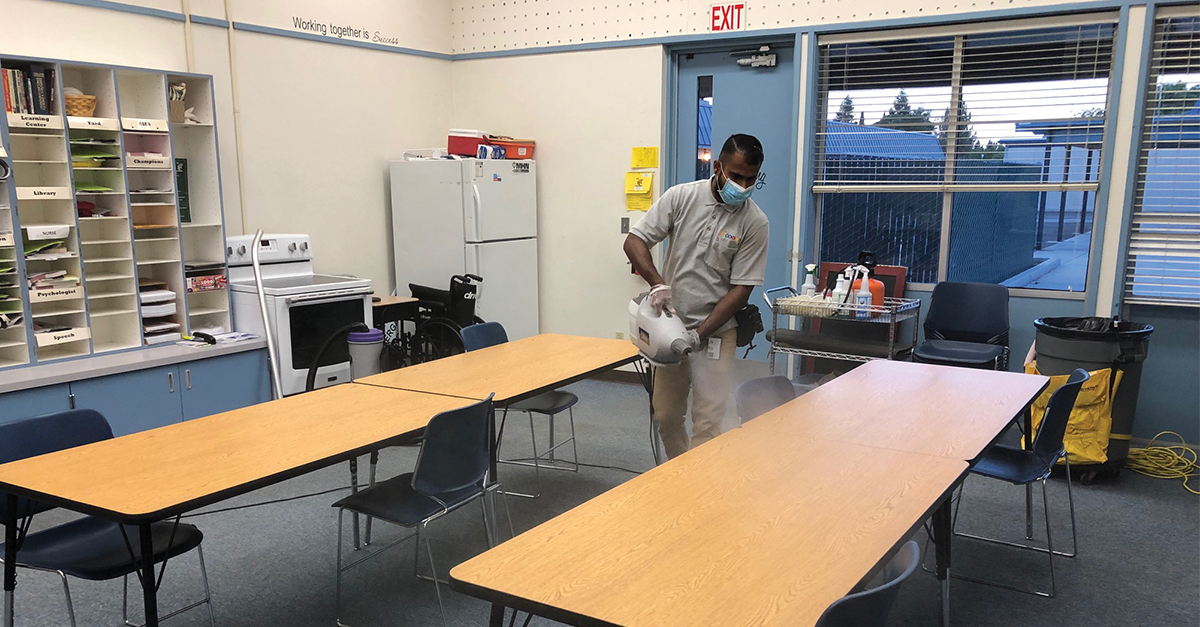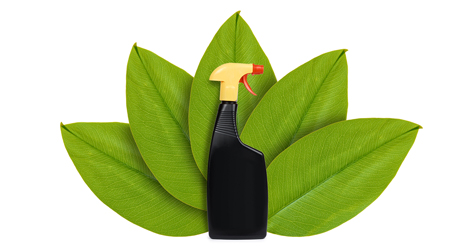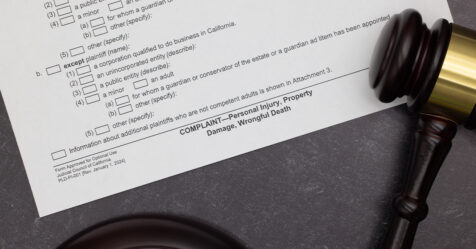As summer waned this year, the question on a lot of people’s minds was how schools would reopen for fall classes. Across the country, K-12 school districts created plans to allow students, teachers, and staff to start the school year safely.
Whether school facilities reopened to students, or just to teachers who would run remote learning from their empty classrooms, one need was apparent—stringent cleaning protocols to keep the SARS-CoV-2 virus at bay. Cleaning professionals responded by examining their current cleaning methods and policies and ramping up their practices where needed.
Hit the books on cleaning frequencies
As a goal of cleaning during a pandemic is to keep students from sharing their germs with classmates, custodians needed to reevaluate their classroom cleaning frequencies. Pre-pandemic, most custodians and school service providers would clean classrooms at the end of the school day, concentrating on restrooms, cafeterias, and other areas that needed immediate attention while students were present. If students remain in one classroom throughout the day, this method will still work. The opportunity for contamination occurs when students switch classrooms, but it is not feasible to do a thorough classroom cleaning in the limited time between class periods.
Service providers who work for SSC Services for Education, a Knoxville, Tennessee-based company that provides facility management and cleaning for more than 150 educational clients in 27 states, have come up with a creative plan to keep students from contaminating classrooms, said Seth Ferriell, CEO of SSC. When students enter classrooms for the first period, they sit only in odd-numbered seats in even rows. Then when students come in for the second period, they sit in the even-numbered seats in odd rows. If classes change two more times, the next groups of students can sit in the even seats in even rows, then the odd seats in odd rows. That allows four sets of students to use a classroom before it needs to undergo a thorough cleaning.
“For the youngest students you can color code the seats, so they know where to sit,” Ferriell said. “For example, the students in first period can sit on a seat with a red dot, then students in second period can sit in a seat with a yellow dot. When all the color dots have been used, we can come in and clean, without having to clean the room after every period.”
Custodians at the Davis School District in Farmington, Utah, the second largest school district in the state, prepared for a school year with half of the students attending class in person Mondays and Wednesdays, and the other half attending Tuesdays and Thursdays. “We have the schools staffed during the day but we wanted to mitigate the impact we had on student learning so we do most heavy-duty cleaning at night,” said Shawna Cragun, who served as the custodial director of the district and is now director of transportation. Cragun is a member of the Healthy Green Schools & Colleges Steering Committee, a group of facility managers from schools and universities across the U.S. with award-winning, pioneering green cleaning programs.
During school attendance hours, custodians will focus on cleaning and disinfecting restrooms multiple times, along with other high-touch areas such as all handrails, push bars, door handles, and light switches. “We’re doing different things like propping doors open so they are not frequently touched, eliminating the use of lockers so students won’t congregate there, replacing water fountains with bottle fillers, and cleaning playground equipment twice a day,” Cragun said. “We will disinfect the school buses between routes.”
Other areas receiving extra cleaning include restroom sinks; urinals; locks on restroom stalls; desks; chairs; and computer screens, mice, and keyboards. “Custodians start at one part of the school, make a circle through the entire school, then when they’re finished, they go through the circle again, so we’re doing continuous cleaning and sanitizing,” Cragun said.
Even if student learning changes to 100% remote at some time during the school year, the custodial staff plans to keep up its continuous cleaning. “We will still have teachers and staff in the buildings providing the remote learning and being there as needed for student appointments, so cleaning will continue to be a priority,” she said.
Students in the Salt Lake City School District in Salt Lake City, Utah, will spend the first quarter, until the end of October, doing remote learning. As a result, custodians in the school district will be focusing on areas other than classrooms, such as gyms and athletic areas, as fall sports have not been canceled. “We will be emphasizing those areas with frequent cleanings; we will be there before the students arrive, while they are there, and after they leave,” said Mervin Brewer, assistant custodial manager of the Salt Lake City School District and a member of the Healthy Green Schools & Colleges Steering Committee.
When students are back in the school buildings, Brewer is confident in the custodians’ cleaning and disinfecting abilities as the district had set up three levels of cleaning protocols long before the pandemic hit.
“The first level is regular cleaning and sanitizing once a day after school, your normal cleanup, however, as flu season hits, we move into a second level with more frequent cleanings, focusing on libraries and cafeteria tables more often,” Brewer said. “We move into the third level for outbreaks, such as norovirus. We clean high-traffic areas multiple times a day and use a stronger disinfectant with a quicker dwell time. We were in that level for most of last year due to the flu, so when COVID-19 hit we didn’t panic.”
Elk Grove Unified School District in Sacramento County, California, also is starting off the school year with remote learning. The school district has a mix of all-year and traditional schedule schools. As teachers and office staff will be in school facilities, along with people who run a meal program for low-income students, custodians will be on-site to clean throughout the day.
“We will be notified who is on campus so we can determine the workload and institute a checklist for each day,” said Tony Almeida, manager of custodial services, maintenance, and operations for the school district as well as a member of the Healthy Green Schools & Colleges Steering Committee. “The lead custodian will be monitoring faculty restrooms throughout the day and cleaning them about three or four times; they are not as heavily used as the student restrooms.”
Once students return to school, the district will reallocate its labor to allow for more frequent surface cleaning. For example, since the district will no longer be offering sit-down meals, but rather grab-and-go breakfasts and lunches, a custodian who previously worked the midday shift hauling away meal trash and cleaning tables will move to the night shift to help with cleaning and sanitizing common touch points throughout the campus.

Spartanburg School District #7, Spartanburg, South Carolina, courtesy of SSC Services for Education
Review products and equipment for school cleaning
Along with examining their cleaning procedures, school custodians and service providers needed to determine if their supplies and equipment were up to the task of pandemic cleaning. SSC service providers are using the same cleaning products they used pre-pandemic, but they switched from cleaning with spray bottles and cloths to more frequent use of electrostatic sprayers.
“We added almost 2,000 electrostatic sprayers to our equipment line for this school year, which is double the amount we had before,” Ferriell said. “With electrostatic cleaning you can cover a larger area in a shorter period of time, which is helpful when you are increasing your cleaning frequencies.”
The Davis School District, Salt Lake City School District, and Elk Grove Unified School District are all staying with their tried-and-true green products. “We don’t want to go so severe in protecting from COVID-19 that we affect kids with respiratory issues such as asthma,” said Cragun.
“Green cleaning is still effective. The cleaners we use are on the EPA N list as effective against the coronavirus,” said Brewer. “I’ve heard how other districts have abandoned their green cleaners because of the pandemic and they had to retrain their custodial staff.”
The Davis and Salt Lake City districts have been using electrostatic sprayers in all of their of schools for several years, and the Elk Grove district has introduced the technology to some of its schools and will continue to expand their use.
Custodians at Elk Grove traditionally used hydrogen peroxide but six years ago the district transitioned half of its schools to hypochlorous acid that it generates onsite, Almeida said. The district recently committed to switching all of its schools to aqueous ozone, which it also will generate onsite.
The Salt Lake City district custodians also generate their own hypochlorous acid cleaning solution onsite, which has helped them avoid shortages in the supply chain.
“We had zero supply issues, we stayed green, and we stayed with our game plan,” said Brewer. “We had a good plan in place before the pandemic; all we had to do was make minor adjustments.”
Work through challenges
Each school district has faced unique challenges in preparing and maintaining its cleaning and disinfecting plans for the 2020-2021 school year. Cragun’s biggest concern is keeping up custodial staffing levels.
“What happens when we get exposure at school? My concern is when 50% of teachers or custodians are sick, either with COVID-19 or something else,” she said.
The Davis School District, along with the others, is taking steps to keep everyone safe by providing masks for the entire student body and staff, installing plexiglass partitions in its reception areas, placing soap in every classroom that has a sink, and placing hand sanitizer in all other classrooms, as well as in the auditorium, cafeteria, buses, and media center.
“We also want our staff to follow good practices outside of work,” Cragun said.
Brewer agreed that staffing will be his school district’s biggest challenge. “On any given day someone is either sick, has a sick kid, a flat tire, etc. You are always struggling with having enough people,” he said. “A pandemic will only magnify that problem. What if entire crews go down? How will we staff properly? We have been given the go-ahead to pay overtime as needed because cleaning for health is a No. 1 priority.”
Brewer said custodians in each of the district’s 38 school facilities are tasked with creating a plan on how to provide adequate staffing as well as a contingency plan for times of low staffing.
Almeida mentioned keeping up with district cleaning practices as the biggest challenge he foresees for the current school year. “If we drift away from our practices, we allow this pandemic to defeat us,” he said. “The ultimate goal is to stay ahead of any health risk and if we consistently do what we are supposed to do every day, we are ahead of the game.”
Changing people’s mindsets about the use of green versus traditional cleaning products has also taken time. “A lot of people think the stronger the product the better, that’s what they know, that’s what they’ve grown up with,” Almeida said. “We have been working to convince them there are alternate technologies that are just as effective if not more.
SSC listed shortages in the supply chain as a significant challenge. “Even simple things like spray bottles and triggers are hot commodities,” Ferriell said. Fortunately, as a larger company, SSC has been able to stockpile items over the summer.
Being a building services provider (BSC) for numerous school districts has provided its own set of challenges. “It’s been hard getting the personalized plans for all the schools,” Ferriell said, explaining each school district has its own practices and has made different decisions on how to handle the new school year. “The next challenge I’m seeing is that the communication is going to need to be ongoing. It’s not enough to be telling teachers and parents we are going to be cleaning every day. They are going to want ongoing communication and reassurance that we are doing everything in our power to keep school staff and students safe.”

Photo courtesy of custodial services, Elk Grove Unified School District, Sacramento County, California
Students and teachers can help with school cleaning
Although school custodians and service providers take responsibility for the cleaning and disinfection of facilities, help from students and staff makes their jobs easier and the results more effective. Cragun said custodial staff in her district has requested that teachers in classrooms with a lot of clutter scrutinize their workspaces and remove items that are not absolutely necessary.
“Doing small things like picking up after themselves will help. The removal of clutter, soft surfaces, and rugs will help us clean better and faster,” she said.
Looser district policies on student attendance also will help stop the spread of germs.
“In a perfect world, everyone would stay home when they are sick, but we don’t have a perfect world. The school district has given an exemption to the high school attendance requirements this year,” Cragun said, explaining that when high school students miss a certain number of days they have to make it up before graduation through fees or community service. “This year we are not looking at attendance, we don’t want that to be a focus that pushes kids to school when they are sick.”
Brewer said each classroom in the Salt Lake City School District will be equipped with a spray bottle containing a low concentration of hypochlorous acid and a roll of paper towels. As students come in the classrooms, they will sanitize their hands and take a paper towel. Teachers will walk up and down the rows of desks and spray them with the disinfectant and the students will wipe them down. Five minutes before class ends, they will repeat those steps. “That simple process is a big help right there,” Brewer said.
Teachers in the Elk Grove School District who agree to help are also being given spray bottles of cleaning solution to wipe down desks and other workstations. “Our district’s motto is ‘stronger together’ so we are encouraging teachers to take opportunities to help and be part of our collaborative process,” Almeida said.
Probably the most meaningful way staff can help custodians is to allow them to do their jobs. As staff understands the importance of cleaning for health over cleaning for aesthetics, they are allowing custodians to go about their work sanitizing areas more frequently. “We are doing less honey-do tasks, like putting up letters on marquis, setting up cones, or reloading soft drink machines,” Brewer said. “We are being treated as the professional health maintenance people we are.”




